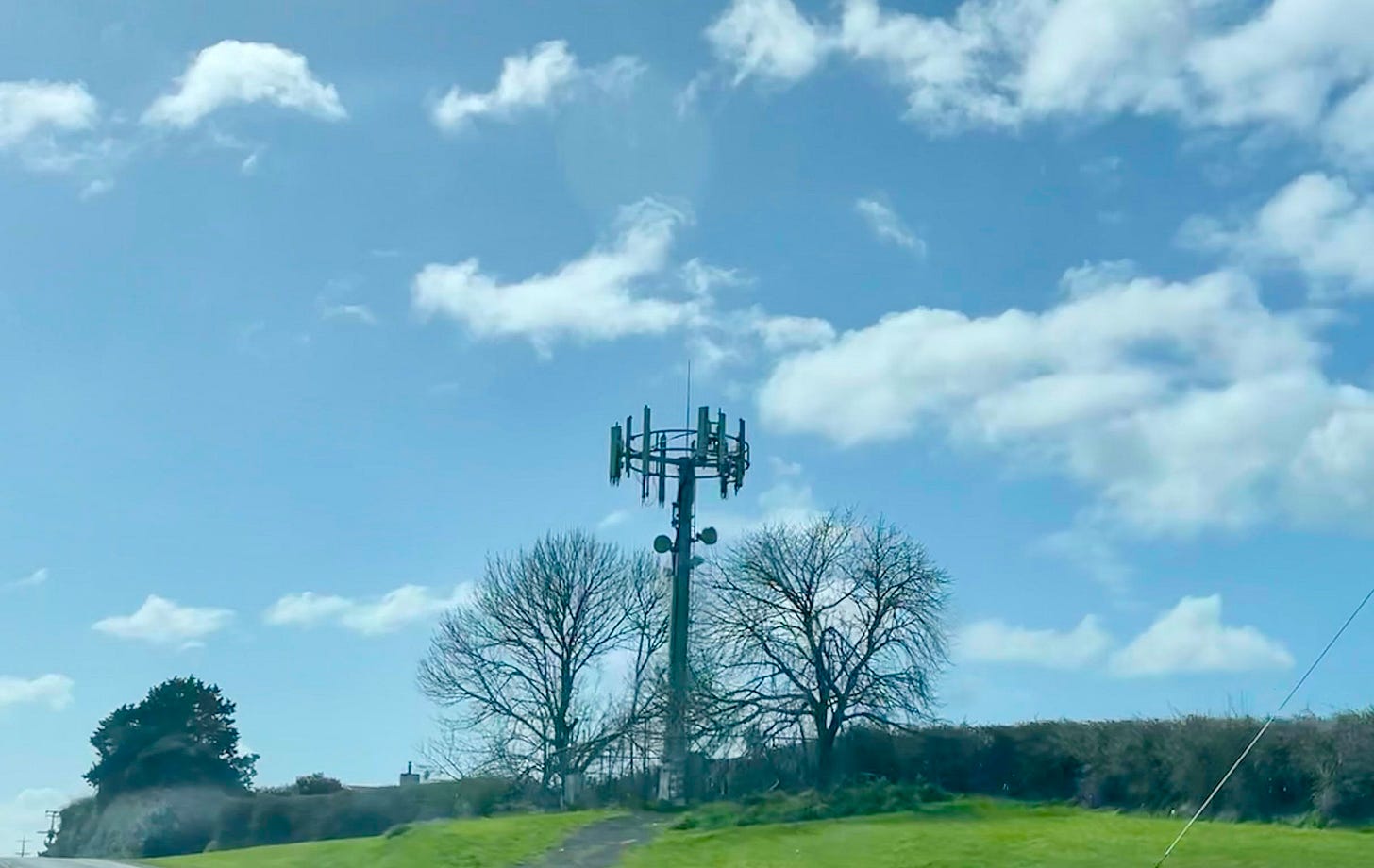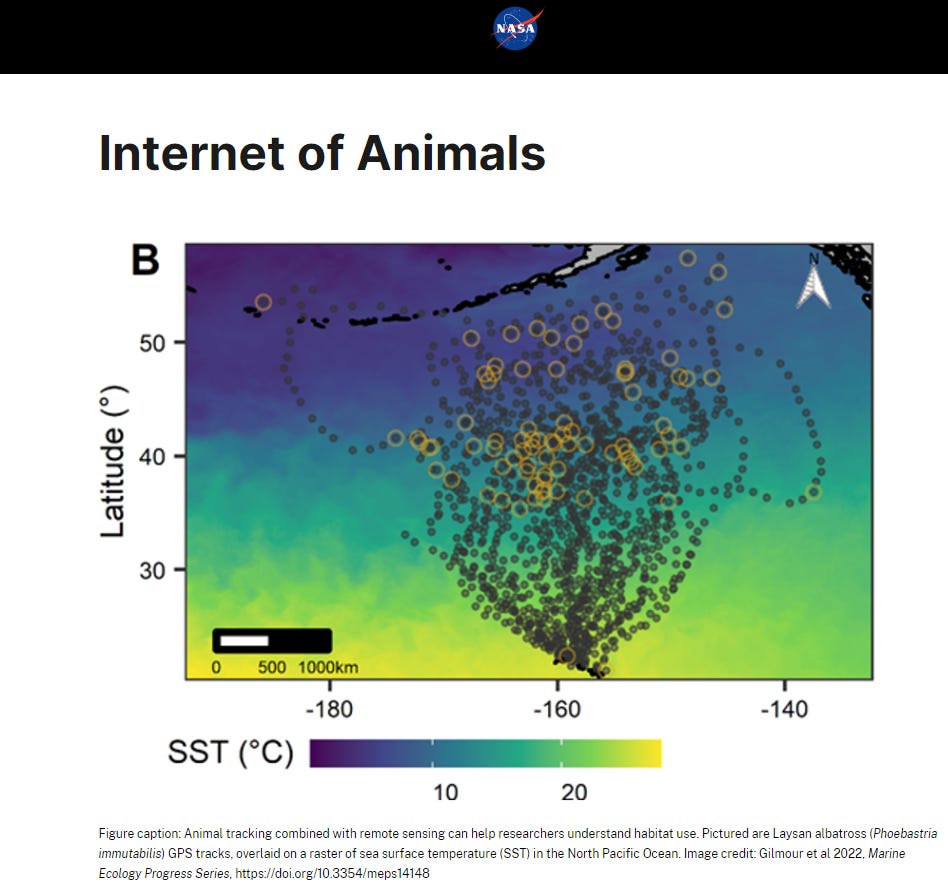5G, AI & Cows: NZ's Internet of Animals
Nudge Units of a different nature, in nature: vibrations, pings and electric shocks...
Some people may think that 5G - with all its ‘pros and cons’ - is mainly an urban issue. Nope. Do you know that millions of cows now wear a type of FitBit or SmartWatch? BigBrother is everywhere, implicit even in the milk you pour over your muesli. Famously, Harari wrote about the Internet of Things and how humans are now “hackable animals”. And in The Internet of Bodies is Here (2000) - a report published by (who else?) the World Economic Forum - the authors warn us that:
Recent technological advancements have ushered in a new era of the “internet of bodies” (IoB), with an unprecedented number of connected devices and sensors being affixed to or even implanted and ingested into the [human] body.
Eeeek! No thanks. But it was part of NASA’s Internet of Animals, more specifically cows, that first ‘benefitted’ from the 5G technology in the UK. In New Zealand, the dairy sector contributes $billions to the economy and is one of its most dominant goods export sectors (e.g. China). So it made sense that NZ would be early adopters of a tech that nudges, pings and shocks cows to respond in certain ways to improve output. And so unsurprisingly, during the covid era, I noticed herds of cows wearing solar-powered collars:
Instead of bouncing over stinking muddy pastures on their quad-bikes in all weathers, farm-workers were stationary, staring at their phones. It comes to something when those closest to nature, our farmers, are turning into tech-addicted zombies.
Were these early tech-driven cows participating in an important pilot project that was aimed at us humans? Nudges are ubiquitous - psychological and physical. Over the last five years, 5G towers have been rolled-out at speed, globally. Even in my tiny settlement in rural NZ we are surrounded by them. Surely there isn’t enough residential subscribers (I thought, naively) to make this new technology worthwhile for the communication companies?
Why I’m concerned.
Merging animals with technology can change their behaviours in certain ways; tech can reduce labour time and costs, maximise [milk] output and increase profits. Sounds great, right? Putting the ethics aside for a moment, marketing companies argue that AI is a way of maximising ‘sustainability’ in quality food production - through surveillance and monitoring. As smaller farms increasingly get taken-over by larger [overseas-owned] corporates, larger herds spread over thousands of hectares present practical and logistical challenges for farm managers. Fencing, grazing, fertility and milking, alongside veterinary interventions (and ‘vaccinations’) require record-keeping and control mechanisms that are extremely time-consuming and demanding.
Well, here’s the good news…
“There’s an App for that!”
According to Vet Ent NZ, the key benefits of cow collars (and ear sensors) include:
Understanding a cow’s eating patterns and rumination
Knowing cow behaviour, movements and location, helping to detect issues early
Heat detection and improved mating results
Heat detection materials no longer required
Improved pasture management (invisible geofencing)
Automated herd movements, saving time
Improving cow quality and performance (are they race-horses?)
Optimised herd productivity
Enabling well informed herd management decisions
Reduce on-farm workload, helping improve farmer work-life balance
(my emphasis)
To learn what this means in reality, here’s a quick example (3.45 mins) of a marketing video (presented by your trusty female vet of course: M=Messenger) explaining what a cow wearable App does and what the results look like:
Note the 10th bullet point (above) is about work/life balance, a great selling-point to hard working farmers. As Bob Moran illustrates:
But this tech is highly reliant upon a 5G signal and a power source. Subscriptions to ‘convenient’ software packages that promote this data-driven approach can also be expensive. This is a source of considerable revenue for BigTech, could it therefore be a potential control mechanism over farmers? For instance: quantitative data about complex details of a farm’s innermost functions can promote specific interventions, like those associated with the impact investors like Legatum that I have written about previously (summary of those here). Nonsense about excessive methane in cow farts has also been linked to the climate change agenda. Who controls this data and what is it used for? I strongly suspect that, like (pet/stock) health insurance, the herd must be ‘fully vaccinated’ to participate?
Local fencing firms are losing business; paddocks that needed regular maintenance on gates and fences, are no longer required. Again, we see how skills that have taken generations to learn, will be lost. Collared cows in ‘easy-to-change’ invisible geo-fenced pastures have parallels with the virtual controls that Agenda 2030 and 15-Minute Cities that I have written about here.

How much is the subscription to these schemes? And is the increase controlled? I see that credit finance is available, too. Crikey. Imagine the risk of being unable to pay the fees plus interest, and suddenly losing the ability to keep your herd contained, or to processes the milking machines? Could the exponential growth of this sector be down to investors betting on a downturn in agribusiness? Could this be yet another way that as
brilliantly and comprehensively explains, private land ownership is under threat?Inevitably, the marketing spin has been busy dismissing any ethical or practical concerns like those I’ve listed above. The narrative claiming BigTech altruism is powerful. For instance, in 2022, a conference organised by Halter, claimed that:
“People outside the industry worried about dairying's social license "quite rightly" question the electric shock, but it's not a big jolt and only a last resort. The negative reinforcement is not to punish them but to reinforce a command that they already ignored,"
It’s perhaps not a coincidence that Halter was a start-up funded by a satellite focused venture capital investor, New Zealand’s Rocket Lab. This returns us to where my article began - the connection between the Internet of Animals and NASA:
I wonder how long it will be, before cows are injected with a device that forms the sort of control and surveillance their collars have already provided for farm-managers for the past five years? Or maybe they already are? Will relationships that farmers have with their animals ever be the same? Are farming skills soon to be lost forever?
I have the excellent series of articles about Transhumanism published in
front of mind whilst writing this post. And ’s recent article also makes some good points about whether - or to what extent - any nanoparticles are ‘controllable’. Wherever the nanoparticles are, and whether ‘spontaneous or directed’, programmed into something worn, attached or injected/ingested, synthetic intrusion is all around us and being ‘hacked’ by AI interventions is not something we should ignore or dismiss. Are you paying attention yet?Most of the research work I undertake is for free. Please help me to help others, by buying me a coffee here.
….Or opting into a voluntary subscription. Thank you!










Comment from another thread on this post: “Yes there has been a marked increase in the use of these devices in farming. [a fellow] farmer was telling us all the features and capabilities of these collars, and they were many. But they are basically there to allow the bulk of the job to be done by people with limited experience in some of the key areas like heat detection, animal health and feeding. It is very expensive. I do know a guy with a 350 cow herd who is using these collars and it costs him $75k per year. He does say it has eliminated a labour unit and simplified the running of his farm. I have also heard that there is chaos when the power goes out and the geofencing is nonfunctional!” Crazy.
Thank you Ursula. I am doing a talk in a few weeks on the transformation of our food systems. And I was going to look at the tracking systems in place, as well as how the word "regenerative" has been co-opted. Your article is very helpful. I'm currently sitting in a CSIRO webinar where they are talking about the Natural Capital markets- where nature and the "services" (i.e. fresh air) nature gives us will be commodified. They've referenced the WEF twice. I'll write about this next deception soon.